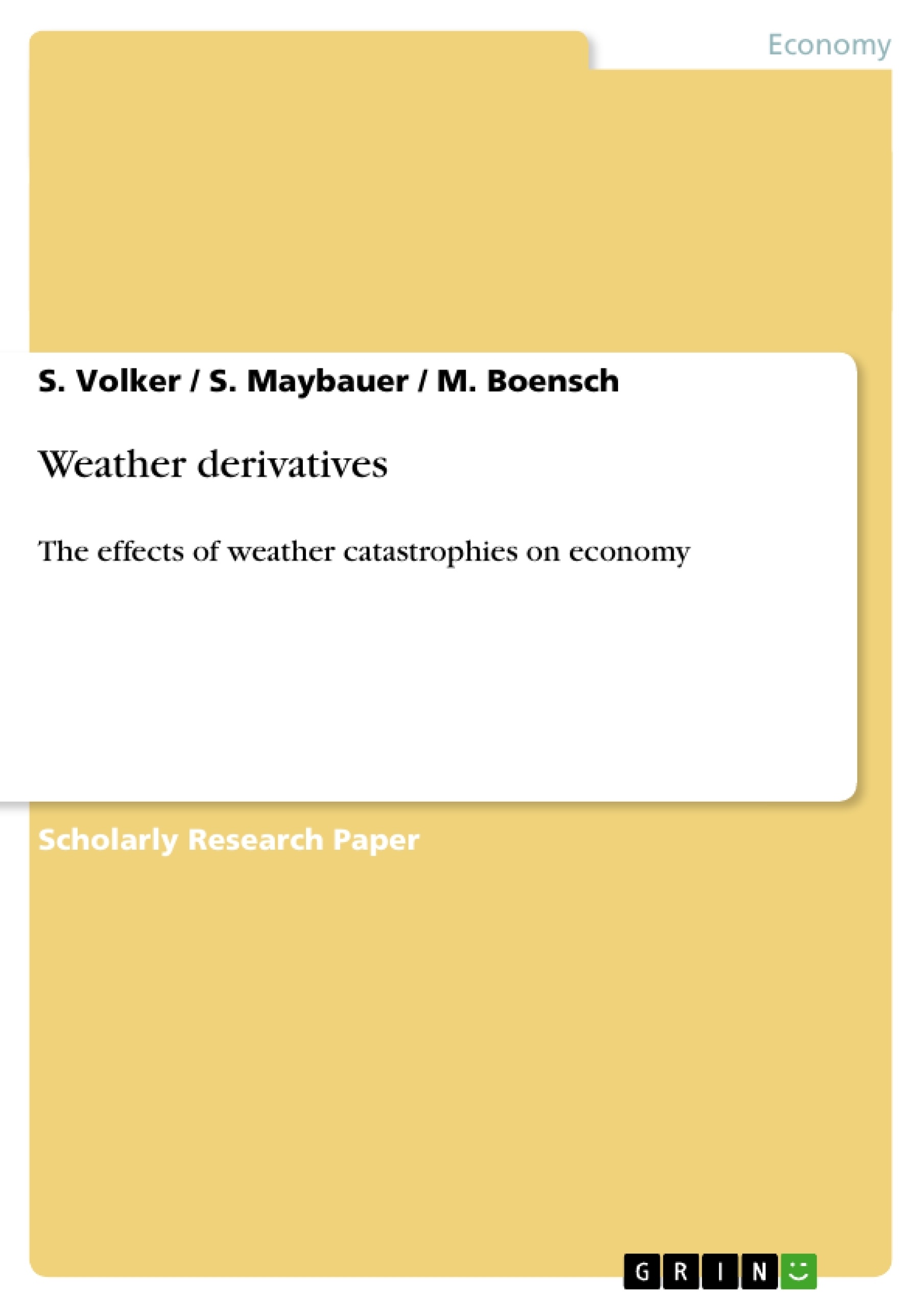The ability to hedge price risks of industrial and consumer goods is well-developed
an widely used, but, for many customers and companies, a variance in the unit volume being caused by a unexpected weather situation can be as detrimental to the
bottom line as unit price variation. In the past, market participants were exposed defencelessly to this risk, because “weather has been anything but predictable…”
There was bundle of incidents in the late 90’s which lead to the development of
weather derivatives as a new, flexible instrument to mitigate risk resulting from
weather: First, the changing world climate causes more often extreme weather situations such as El Nino. Weather catastrophes like the hurricanes Katrina and Rita in the USA, summer flood of 2002 and the desert summer of 2003 in Germany have been increasing the awareness of weather risks among the population and in the management of the companies. Unforeseen weather conditions may cause a decline in companies’ earnings. It is likely to imagine, that, for example, a cold and rainy summer will lead to a plummeting consumption of ice cream. In times of an upward tending importance of the shareholder value approach, a professional and effective risk management is inalienable. Insurance policies can cover catastrophic damages, but derivatives are an efficient tool to face financial risks resulting from the weather and to stabilize earnings. Secondly, the worldwide markets are changing. Formerly strictly regulated markets show an ongoing trend of deregulation and therefore a development from monopolies to wholesale markets. Facing a new, competitive situation, companies have to realize, that it does not last to hedge the unit price of their goods. In the mid 90’s, during the liberalization of the American energy market, managers recognized the volumetric risk as a critical parameter influencing companies revenues and expenses. Up to the development of the first weather derivatives, there
had been no possibility to cover these risks.
Inhaltsverzeichnis (Table of Contents)
- 1. Introduction
- 1.1. Description of the problem
- 1.2. Objective of the work
- 1.3. Scope of work
- 2. Risk Management and derivatives: Theoretical background
- 2.1. Risk Management
- 2.1.1. Definition of Risk
- 2.1.2. Necessity of Risk Management
- 2.2. Derivatives
- 2.2.1. Characteristics and functionality
- 2.2.2. Types of derivatives
- 2.2.2.1. Forwards and Futures
- 2.2.2.2. Options
- 2.2.2.3. Swaps
- 2.2.2.4. Caps, Floors and Collars
- 2.2.3. Actors in the market
- 2.2.3.1. Hedgers
- 2.2.3.2. Speculators
- 2.2.3.2. Arbitrageurs
- 3. Weather derivatives
- 3.1. Definition and differentiation
- 3.2. Evolution
- 3.3. Field of application
- 3.3.1. Companies and public institutions
- 3.3.2. Financial institutions
- 3.3.3. Investors
- 3.4. Structure
- 3.5. Underlying
- 3.5.1. Temperature
- 3.5.2. Precipitation
- 3.5.3. Wind
- 3.6. Methods of valuation
- 3.6.1. Black & Scholes
- 3.6.2. Burn-Analysis
- 3.6.3. Monte-Carlo-Simulation
- 3.6.4. Stochastic models
- 3.7. Problems in application
- 3.7.1. Pricing
- 3.7.2. Legal and fiscal formalities
- 3.7.3. Regulation of markets
- 4. Example of use
- 4.1. Contract parties
- 4.2. Contract parameters
- 4.3. Outcome
- 4.4. Other examples
- 5. Summary and outlook
Zielsetzung und Themenschwerpunkte (Objectives and Key Themes)
The authors aim to provide a comprehensive overview of weather derivatives as a risk management tool. This case study analyzes the theoretical background of risk management and derivatives, explores the evolution and applications of weather derivatives, examines various valuation methods, and discusses challenges in their implementation. It also includes an illustrative example of a weather derivative contract.
- Risk management and derivative instruments
- Weather derivatives: definition, evolution, and application
- Weather derivatives as a tool for risk management
- Valuation methods for weather derivatives
- Challenges and opportunities in the use of weather derivatives
Zusammenfassung der Kapitel (Chapter Summaries)
Chapter 1 introduces the case study, outlining its objective, scope, and the problem it addresses. Chapter 2 lays the theoretical groundwork, defining risk and the necessity of risk management, then exploring the characteristics and functionality of derivatives, including various types like forwards, futures, options, swaps, and caps, floors, and collars. It also identifies the major actors in the derivatives market. Chapter 3 focuses on weather derivatives, defining them, tracing their evolution, and examining their application in various sectors, including companies, public institutions, and financial institutions. It dives into the structure of weather derivatives, discusses the underlying factors like temperature, precipitation, and wind, and explores different valuation methods. Finally, it highlights the challenges in applying weather derivatives, including pricing, legal and fiscal formalities, and market regulation. Chapter 4 presents a specific example of a weather derivative contract, detailing the contract parties, parameters, and outcome. The chapter also discusses other examples of weather derivative applications.
Schlüsselwörter (Keywords)
The key concepts and themes explored in this case study include risk management, derivatives, weather derivatives, hedging, valuation, pricing, legal and fiscal aspects, market regulation, and applications in various sectors like energy, agriculture, and insurance.
- Arbeit zitieren
- S. Volker (Autor:in), S. Maybauer (Autor:in), M. Boensch (Autor:in), 2006, Weather derivatives, München, GRIN Verlag, https://www.grin.com/document/62647



